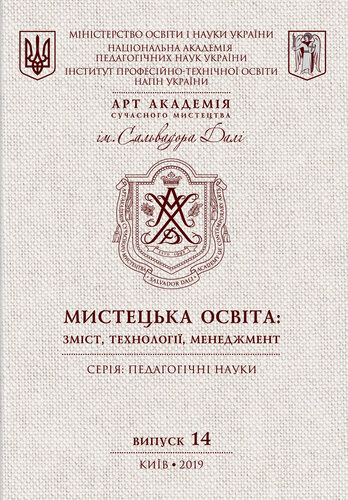COMPOSITION ANALYSIS AS THE BASIS OF THE DIDACTIC EXERCISES SYSTEM IN THE DISCIPLINE «COSTUME HISTORY»
Abstract
The article discusses the principles and structure of building a didactic exercise system in the discipline "Costume History" for future designers. The expediency of constructing such a system of exercises and tasks where the system-forming factor is the compositional analysis of the suit is substantiated. The content of the concept of the compositional analysis of the historical costume in this study is disclosed. The most important elements of the costume composition that form the basis of the content of the developed exercise system are considered: silhouette, form, color scale, proportions, ornamentation, decoration, rhythm, static dynamics, symmetry-asymmetry, contrast-nuance-identity. Brief characteristics of each type of didactic exercises in costume history are presented. The different weights of different components of the composition in different historical costumes have been taken into account when developing exercises for compositional analysis. The article describes the structuring of the developed exercises and tasks in terms of complexity. The expediency of its gradual growth from reproductive, aimed at simple recognition, reproduction, addition to independent creative ones, which involve analysis, comparison and independent development of new forms of clothing with reliance on the compositional elements of the historical costume, is proved. The author stated that all exercises of the developed system can be divided into preparatory, training and final exercises. Preparatory exercises help to eliminate gaps in basic knowledge of composition. Training exercises help to form the ability to analyze the individual elements and composition of the suit as a whole. Such exercises include tasks of a comparative nature, by instruction, by model, by task.
References
Bіlan M. S., Stel'mashchuk G. G. Ukraїns'kij strіj. L'vіv: PP «Vid-vo «Aprіorі», 2011. 315 s.
Ermilova V. V. Kompoziciya kostyuma: ucheb. posob. dlya SPO / V. V. Ermilova, D. YU. Ermilova, N. B. Lyahova, S. A. Popov. 3-e izd., ispr. i dop. Moskva: Izd-vo YUrajt, 2018. 449 s. (Seriya: Professional'noe obrazovanie).
Kibalova L., Gerbenova O., Lamarova M. Illyustrirovannaya enciklopediya mody / per. na russ. yaz. I. M. Il'inskoj i A. A. Losevoj. Praga: Artiya, 1987. 608 s.
Kornic'ka L. A. Hudozhnє proektuvannya odyagu. Іstorіya kostyuma: navch. posіbn. L'vіv: Novij Svіt 2000, 2017. 434 s.
Osnovi ob’єmno-prostorovoї kompozicії: navch. posіb. / YU. V. Іdak, T. M. Klimenyuk, O. J. Lyaskovs'kij; M-vo osvіti і nauki Ukraїni, Nac. un-t «L'vіv. polіtekhnіka». L'vіv: Vid-vo L'vіv. polіtekhnіki, 2014. 212 s.
Mercalova M. N. Kostyum raznyh vremen i narodov. V 4-h tomah. T. 1. Moskva: Akademiya Mody, 1993. 543 s.
Nіkolaєva T. O. Іstorіya ukraїns'kogo kostyuma Kiїv: Libіd', 1996. 171 s.
Plaksina E. B. Istoriya kostyuma. Stili i napravleniya: ucheb. posob. dlya stud. uchrezhd. sred prof. obrazovaniya / E. B. Plaksina, L. A. Mihajlovskaya, V. P. Popov; pod red E. B. Plaksinoj. 2-e izd, ster. Moskva: Izdatel'skij centr «Akademiya», 2004. 224 s.
Sisoєva S. O. Іnteraktivnі tekhnologії navchannya doroslih: navch.-metod. posіbn. Kiїv: VD «EKMO», 2011. 324 s.
Stamerov K. K. Narisi z іstorії kostyumіv. CH.1. – Kiїv: Mistectvo, 1978. 244 s.
CHernyshev O. V. Formal'naya kompoziciya. Tvorcheskij praktikum. Minsk: Harvest, 1999. 312 s.
SHevnyuk O. L. Іstorіya kostyuma: navch. posіb. Kiїv : Znannya, 2008. 375 s.
Historia mody. Redakcja naukowa Marnie Fogg. Warszawa: Wydawnictwo Arkady, 2016. 576 s.

This work is licensed under a Creative Commons Attribution-NonCommercial 4.0 International License.

